
8 Days Lhasa to Everest Base Camp Small Group Tour
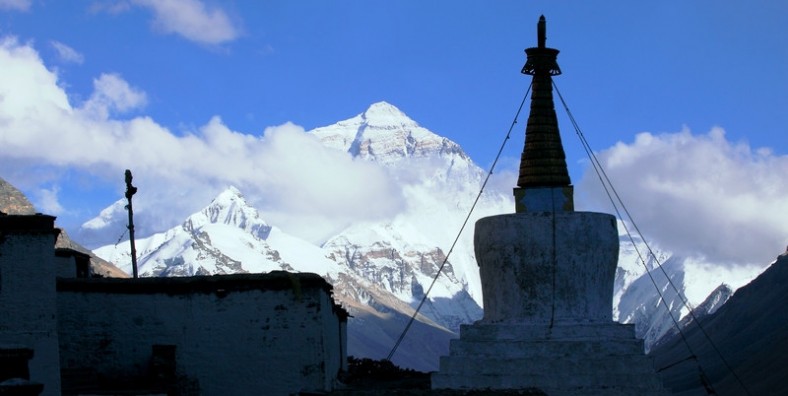
Tour Overview
This 8-day Lhasa to Everest Base Camp tour is our best-selling tour package among all group tours because it not only has covered all the most important and recommended...
Code of Tour: YCT0000003574
Length of Travel: 8 Day
Destinations of Tour: Lhasa / Gyantse / Shigatse / Everest / Lhasa
Departure City: Lhasa
Price of Tour: Request
Type of Tour:
Features of Tour: Nature Culture History Minority Landscape
This 8-day Lhasa to Everest Base Camp tour is our best-selling tour package among all group tours because it not only has covered all the most important and recommended attractions in Tibet, but also has always offered a budget price. You will take the most classic tourist route – “Golden Triangle Destination + Mount Everest”. After exploring Lhasa highlights, such as Potala Palace, Jokhang Temple, Sera Monastery Buddhism Debating, you will travel to Shigatse via Gyantse, and visit beautiful Yamdrok Lake on route. Then extend your adventure to the “Roof of the World” Mount Everest to conquer this highest mountain in the world.
Highlights
- Explore the most featured sites of authentic Tibetan culture in the holy city Lhasa by visiting the grand Potala Palace, holy Jokhang Temple, interesting Sera Monastery Buddhism Debating, etc;
- Enjoy the beautiful land travel from Lhasa to Mount Everest – tranquil Yamdrok Lake, imposing Karola Glacier, unique Palcho Kumba, the snow-capped mountains, blue skies;
- Fulfill your lifetime adventure to the highest mountain in the world – Mount Everest;
Brief Itinerary
Day 1: Lhasa Arrival
Day 2: Lhasa
Day 3: Lhasa
Day 4: Lhasa-Shigatse
Day 5: Shigatse – Mount Everest
Day 6: Rongbuk Monastery – EBC – Shigatse
Day 7: Shigatse – Lhasa
Day 8: Lhasa Departure
Google Map
Detailed Itinerary
Day 1 Lhasa Arrival
Sightseeing and Activities:Train station or airport pick-up, Lhasa city tour
Accommodation: Lhasa
Meals: none
You are warmly greeted to Tibet by hearing Tashi Delek at the Train station/airport from the local guide, and then be escorted to your reserved hotel in Lhasa. After arrival at your hotel, the rest of the day is free for you to explore the local area and acclimate yourself to the high altitude and weather of Lhasa.
In today(or tomorrow)’s evening, a welcome dinner will be held to meet other members of this group tour. Enjoy the party.
Tips of today: 1. Go for some walking to acclimate the high altitude but avoid strenuous activities; 2. You’d better not have bath; 3. Drink more water.
Day 2 Lhasa
Sightseeing and Activities:Drepung Monastery, Sera Monastery
Accommodation: Lhasa
Meals: breakfast

After breakfast, your tour guide will pick you up in your hotel. Then drive about 30 minutes to visit the Drepung Monastery. This Gelug monastery has a history of more than 500 years. It used to be the largest monastery in the world with totally 10,000 monks there. Many precious stupas, sculptures, paintings, Thangka…are displayed in the hundreds of chapels. And the annual Shoton Festival is organized here.
In the afternoon, you will visit another famous Gelug monastery around Lhasa city – Sera Monastery, which is famous for its “Buddhism Scriptures Debating”. It is only 3km away from Lhasa city. Enjoy the debating.
Tips of today: 1. Feel free to ask tour guide questions about Buddhism or else; 2. Obey Buddhist manners and talk appropriately; 3. If you don’t know where to have meals, restaurant in your hotel is a great choice.
Day 3 Lhasa
Sightseeing and Activities:Potala Palace, Jokhang Temple, Barkhor Street, Thakangka workroom
Accommodation:Lhasa
Meals:breakfast
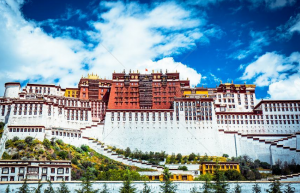
The overwhelming Potala Palace is your first stop. As the symbol of Tibet, it was built in 641 AD and was the winter palace of Dalai Lama who is Tibet’s pope. Impressive Tibetan architecture, huge golden Buddha statues, red-robed lamas and devoted pilgrims all make it a must-visit.
And then you’ll visit the Jokhang Temple, the spiritual center of Tibet. Every day, pilgrims from every corner of Tibet trek here from long distances to worship. Finally, walk the special circular pilgrimage route as local followers always do at Barkhor Street. You will have chance to get close to appreciate how the artists draw Thangkas at the Thakangka workroom at Barkhor.
Tips of today: 1. Wear hat and sun glasses to prevent ultraviolet radiation, but remember to take off when visiting in the monasteries. 2. Usually taking photos is not allowed in chapels inside monastery. 3. Remember to bring your passport which is needed to showcase when check in Potala Palace.
Day 4 Lhasa – Shigatse
Sightseeing and Activities:Mt. Nojin Kangtsang, Karo-la Glacier, Palkor Monastery, Kubum Stupa
Accommodation: Shigatse
Meals:breakfast
After breakfast, leave Lhasa city, and drive along the Ngachu Valley and cross the Kamba La Pass(altitude: 5,030m), you will get to the famous holy lake Yamdrok. It is one of the clearest lakes without any pollution in Tibet. The water is as clean as crystal, and the glimmering water will shock you in sunshine. Far in the distance you’ll spot the towering mass if Mt. Nojin Kangtsang (altitude: 7191m). After the sightseeing, keep driving to Gyantse. On route, you will pass by the imposing Karola Glacier (5045m) along the highway. After arrival at Gyantse, go to visit the elegant Palkor Monastery. The highlight is the Kubum Stupa has a 35m-high chorten with its white layers trimmed with decorative stripes and its crown-like golden dome.
Leave Gyantse, and drive about 2 hours to Shigatse City, the second largest city in Tibet.
Tips of today: 1. Wear warm clothes to prevent from cold and wild; 2. Get your passport prepared for application of Allien’s Travel Permit when arrival at Shigatse.
Day 5 Shigatse – Mount Everest
Sightseeing and Activities: Mt. Everest, Rongbuk Monastery
Accommodation:Rongbuk Monastery Guest House
Meals:breakfast
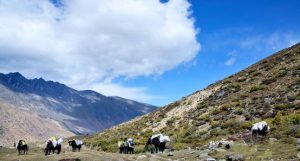
After breakfast, set out to chase the journey to the peak of the world – Mt. Everest. Departing from Shigatse city, via Lhatse, you will witness spectacular high plateau views that you can never see in other places – super blue sky, float light clouds, stretching snow mountains, endless grasslands… Finally you will reach the outstanding Everest. Stop at the foot of Rongbuk Monastery, the highest monastery in the world. Enjoy the intoxicating view of Mt. Everest. (Rongbuk Monastery visiting is optional at your own expense, and charges 35 RMB)
Overnight at Rongbuk Monastery Guest House or local Tibetan tents.
Tips of today: 1. Bring more food and drinks for long driving; 2. Bring a warm and thick coat for low temperature in Everest; 3. Avoid strenuous activity.
Day 6 Rongbuk Monastery – EBC – Shigatse
Sightseeing and Activities:The sunrise of Mt Everest, Everest Base Camp
Accommodation:Shigatse
Meals:breakfast
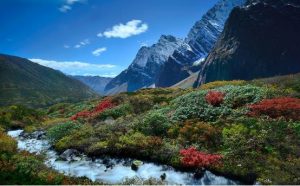
Wake up early to enjoy the marvelous sunrise on the peak of the world. After breakfast, take a sightseeing bus to the Everest Base Camp which is about 8 km from Rongpuk Monastery. While you can also hike up if you are energetic. In the EBC, you can get the best Everest view. The peak is blessed with many extreme wonders. The top part of the mountain is covered with snow all the year round, when the sun shines on the mountain, the peak is like white pyramid. More often, the thick freely moves clouds and fogs, seems as if a flag with the mast of the peak was swinging, will shroud the peak. This peculiar phenomenon of Mt. Everest is known as “Flag Cloud”. An additional wonder generated here are the bright glaciers, where ices are formed into various shapes like bridges, pagodas and others.
Lastly, go down from EBC back to Rongpuk Monastery area, and drive along the coming way back to Shigatse.
Stay overnight in Shigatse city.
Tips of today: 1. Sunrise starts around 6:30 am to 7 am. 2. Get well prepared for long driving on the road.
Day 7 Shigatse – Lhasa
Sightseeing and Activities:Tashilhunpo Monastery
Accommodation: Lhasa
Meals:breakfast
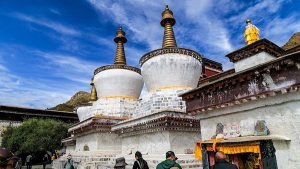
Today, before returning back to Lhasa, you will go to visit one of the most important monasteries in Tibet – Tashilhunpo Monastery. It is coveniently located in Shigatse City.
Tashilhunpo Monastery, founded in 1447, is recorded hightest monastery in the Gelukpa tradition, and has been the official seat of sucessive Panchen Lamas for centuries, which makes it very popular with pilgrims. The monastery is an interesting sprawling amalgam of traditional Tibetan monastic style halls, chapels and other structures connected by precipitous steps and narrow cobblestone alleys. The interplay between Tashilumpo’s golden roofs and its white, red and black exterior walls creates a striking composition. Here you will see a giant statue of Future Buddha, the largest one of its kind on earth ( 26.2 meters high and 11.5 meters wide ), decorated with precious pearls, turquoises, corals and ambers.
Lastly, leave Shigatse, and drive about 5~6 hours to back to Lhasa. Have a good rest.
Day 8 Lhasa Departure
Sightseeing and Activities:Depart from Lhasa
Accommodation:None
Meals:breakfast
Today is free for you until your tour guide transfer you to the airport in time for your flight or drop you off at Lhasa train station.
Tips of today: 1. Please pack your luggage carefully, especially for small things like camera charger, power adaptor, mobile phone, phone charger, wallet and towel. 2. If your flight is arranged in the afternoon, please make sure you check out the hotel before 12pm.
Recommended Hotels
| City | 5 Star | 4 Star | 3 Star |
|---|
Quotations
| Group size(person) | 5 Star ($) | 4 Star ($) | 3 Star ($) |
|---|---|---|---|
| 12 |
Service Included
- Tibet Entry Permit and Alien’s travel Permit
- Transport
- Transfer between airport/train station and Lhasa city – Lhasa City transportation – Lhasa-Gyantse-Shigatse-EBC-Lhasa
- Admission fee of All tourist sites listed in Itinerary
- Environment friendly local bus between Rongpuk and EBC
- Hot water bottle and sleeping bag provided in Winter while traveling to EBC.
- Oxygen provided while traveling to EBC.
- Professional Tibetan English speaking tour guide
- Travel Agency Service Charge
- Accommodation-comfortable 2 or 3-star facility Accommodation sharing twin room with breakfast buffet in Lhasa and Shigatse; – tent or Guest House at Rongpuk.
- One welcome dinner in Lhasa
Service Excluded
- Single room supplement.
- China visa, all air tickets and train tickets to and from Tibet.
- Sightseeing not listed in the itinerary.
- Meals not listed in the itinerary (all lunches and dinners).
- Personal expenses such as laundry, drink, fax, telephone call, optional activities, etc.
- Gratuities, tips to guides, drivers, bellboys, etc.
- Excess Baggage Charges.
Travel Tips:
1. What Are the Features of Our Group Tours
Our Group Tours are budget tour packages with great service which have covered the most popular destinations in Tibet with reasonable trip lengths. Joining in our group tours, you will choose your travel dates from our fixed departures and travel in a small group with maximum members of 12 people.
2. Tibet Permits
There are several permits required to visit Tibet. Tibet Entry Permit, issued by Tibet Tourism Bureau, is the most important one which has to be obtained before your trip because you must have it to take your flight/train to Tibet. To get the permit, you have to book a Tibet tour with us, and send us your passport and Chinese visa about 20 days in advance, and then let us apply for the permit (all Tibet permits can only be applied by travel agency). If you travel to other prefectures like Shigatse, Nyingchi, Shannan, etc, you also have to obtain an Alien Travel Permit. If you travel to Mount Everest, you have to obtain a Border Permit. (Tibet Discovery, with office in Lhasa, has always kept up with the latest news on Tibet Permits. Traveling with us, all your permits are guaranteed as long as you are qualified to the requirements.)
3. Available Months to Visit Tibet
Generally speaking, May to early October is the recommended time to have a Mount Everest trip. July and August are the peak season and rainy season. The temperatures in daytime and night differs a lot, usually 5~15℃ in the daytime and -5~0℃ in the night, so please keep warm all the time. It is usually snowy and cold in winter, which is not suitable for visit Mount Everest. While other places like Lhasa, Gyantse and Shigatse are suitable for travel all year around.
4. High Altitude Sickness
The average altitude of Tibet is about 4000 meters above the sea level (Lhasa: 3700m; EBC: 5200m; Namtso: 4718m). You may suffer a bit from High Altitude Sickness in the beginning days of your Tibet trip if you haven’t had rich high plateau travel experience. But don’t worry too much, the high altitude can be acclimatized usually in 2~3 days. Our suggestion is to take a physical examination and get suggestions from your doctor, and also bring some medicines to prevent from High Altitude Sickness before your trip. While in Tibet, you should keep warm all the time, avoid strenuous activities, drink more water and eat more vegetables and carbohydrates. You’d better not take showers during the first two days after your arrival at Tibet. If you don’t feel well, get help from your tour guide or go to the hospital without any delay.
5. How to Go to Tibet
Basically you have two options – flight and train. Currently, you can take a flight to Lhasa from Beijing(4.5hrs), Xian(3.7hrs), Chengdu(2.5hrs), Chongqing(3hrs), Kuming(3hrs), etc. Among all these cities, Chengdu and Xian have more frequent flights to Lhasa. Kathmandu also has several flights to Lhasa each week.
If you a train travel, you can take a train to from Beijing(40.5hrs), Xian(32hrs), Chengdu(43hrs), Shanghai(47hrs), Chongqing(42hrs), Lanzhou(25hrs), Xining(22hrs), Guangzhou(54hrs).
6. Packing and Wearing Ideas
Firstly you can’t forget your passport and Chinese Visa. A large backpack and a smaller one are recommended (the smaller one can be used for daily activities). Also bring the necessary medicine you need. Other stuffs like sunglasses, snow glasses, hats, lip balm, sun block are recommended.
As for wearing, you are suggested to dress in layers (both thin and thick jackets). Down jacket is necessary in Spring and Autumn. A pair of durable and comfortable shoes is necessary.

















